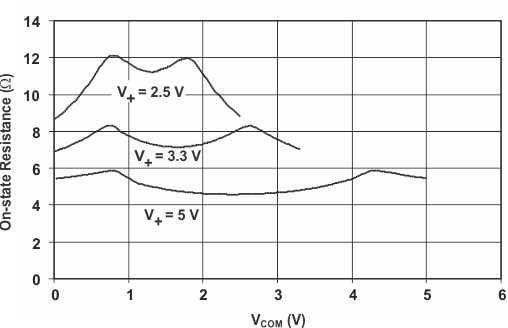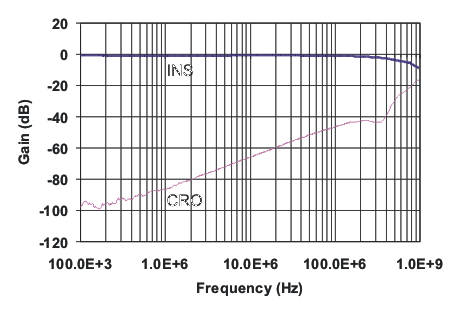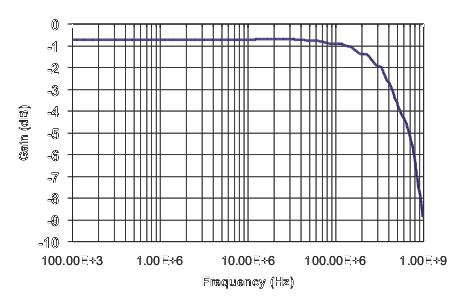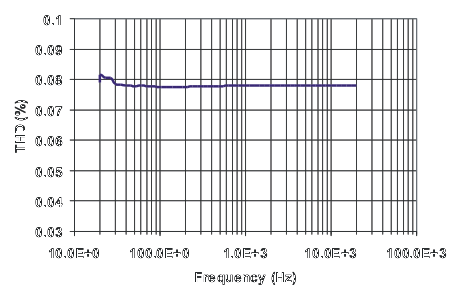SCDS241B May 2008 – December 2016 TS5A9411
PRODUCTION DATA.
- 1 Features
- 2 Applications
- 3 Description
- 4 Revision History
- 5 Pin Configuration and Functions
- 6 Specifications
- 7 Parameter Measurement Information
- 8 Detailed Description
- 9 Application and Implementation
- 10Power Supply Recommendations
- 11Layout
- 12Device and Documentation Support
- 13Mechanical, Packaging, and Orderable Information
6 Specifications
6.1 Absolute Maximum Ratings
over operating free-air temperature range (unless otherwise noted)(1)(2)| MIN | MAX | UNIT | ||
|---|---|---|---|---|
| Supply voltage | –0.3 | 6 | V | |
| Analog voltage(3) | –0.3 | VCC + 0.3 | V | |
| Digital input voltage | –0.5 | VCC + 0.3 | V | |
| Analog port diode current (VNC, VNO, VCOM < 0) | –50 | mA | ||
| Digital input clamp current (VI < 0) | –50 | mA | ||
| Continuous current through VCC | 100 | mA | ||
| Continuous current through GND | –100 | mA | ||
| Storage temperature, Tstg | –65 | 150 | °C | |
(1) Stresses beyond those listed under Absolute Maximum Ratings may cause permanent damage to the device. These are stress ratings only, which do not imply functional operation of the device at these or any other conditions beyond those indicated under Recommended Operating Conditions. Exposure to absolute-maximum-rated conditions for extended periods may affect device reliability.
(2) All voltages are with respect to ground, unless otherwise specified.
(3) This value is limited to 5.5 V (maximum).
6.2 ESD Ratings
| VALUE | UNIT | |||
|---|---|---|---|---|
| V(ESD) | Electrostatic discharge | Human-body model (HBM), per ANSI/ESDA/JEDEC JS-001(1) | ±2000 | V |
| Charged-device model (CDM), per JEDEC specification JESD22-C101(2) | ±1000 | |||
(1) JEDEC document JEP155 states that 500-V HBM allows safe manufacturing with a standard ESD control process.
(2) JEDEC document JEP157 states that 250-V CDM allows safe manufacturing with a standard ESD control process.
6.3 Recommended Operating Conditions
over operating free-air temperature range (unless otherwise noted)| MIN | MAX | UNIT | |||
|---|---|---|---|---|---|
| VCC | Supply voltage | 2.25 | 5.5 | V | |
| VNO | Analog voltage | NC | 0 | VCC | V |
| VNC | NO | 0 | VCC | ||
| VCOM | COM | 0 | VCC | ||
| VI | Digital input voltage | 0 | 5.5 | V | |
| ON-state switch current (VNO, VNC, VCOM = 0 to VCC) | –50 | 50 | mA | ||
| ON-state peak switch current (VNO, VNC, VCOM = 0 to VCC)(1) | –200 | 200 | mA | ||
(1) Pulse at 1-ms duration < 10% duty cycle
6.4 Thermal Information
| THERMAL METRIC(1) | TS5A9411 | UNIT | |
|---|---|---|---|
| DCK (SOT) | |||
| 12 PINS | |||
| RθJA | Junction-to-ambient thermal resistance | 346.7 | °C/W |
| RθJC(top) | Junction-to-case (top) thermal resistance | 163.7 | °C/W |
| RθJB | Junction-to-board thermal resistance | 154.5 | °C/W |
| ψJT | Junction-to-top characterization parameter | 17.4 | °C/W |
| ψJB | Junction-to-board characterization parameter | 153.8 | °C/W |
(1) For more information about traditional and new thermal metrics, see the Semiconductor and IC Package Thermal Metrics application report.
6.5 Electrical Characteristics: 5-V Supply
VCC = 5 V, TA = 25°C (unless otherwise noted)| PARAMETER | TEST CONDITIONS | MIN | TYP | MAX | UNIT | |||
|---|---|---|---|---|---|---|---|---|
| ANALOG SWITCH | ||||||||
| rON | ON-state resistance | VNO or VNC = 3 V, VCC = 4.5 V, ICOM = –10 mA, Switch ON, see Figure 5 |
TA = 25°C | 5.3 | 9 | Ω | ||
| –40°C ≤ TA ≤ 85°C | 10 | |||||||
| ΔrON | ON-state resistance match between channels | VNO or VNC = 3 V, VCC = 4.5 V, ICOM = –10 mA, Switch ON, see Figure 5 |
TA = 25°C | 0.03 | 0.3 | Ω | ||
| –40°C ≤ TA ≤ 85°C | 0.3 | |||||||
| rON(FLAT) | ON-state resistance flatness | 0 ≤ (VNO or VNC) ≤ VCC, VCC = 4.5 V, ICOM = –10 mA, Switch ON, see Figure 5 |
2 | Ω | ||||
| INC(OFF), INO(OFF) | NC, NO OFF leakage current | VNC or VNO = 1 V and VCOM = 1 V to 4.5 V, or VNC or VNO = 4.5 V and VCOM = 1 V; VCC = 5.5 V, Switch OFF, see Figure 6 |
TA = 25°C | –500 | 500 | pA | ||
| –40°C ≤ TA ≤ 85°C | –3 | 3 | nA | |||||
| INC(ON), INO(ON) | NC, NO ON leakage current | VNC or VNO = 1 V and VCOM = 1 V, or VNC or VNO = 4.5 V and VCOM = 4.5 V; VCC = 5.5 V, Switch ON, see Figure 7 |
TA = 25°C | –500 | 500 | pA | ||
| –40°C ≤ TA ≤ 85°C | –3 | 3 | nA | |||||
| ICOM(ON) | COM ON leakage current | VNC or VNO = Open, VCOM = 1 V or 4.5 V, VCC = 5.5 V, Switch ON, see Figure 7 |
TA = 25°C | –500 | 500 | pA | ||
| –40°C ≤ TA ≤ 85°C | –3 | 3 | nA | |||||
| DIGITAL INPUT (IN)(1) | ||||||||
| VIH | Input logic high | –40°C ≤ TA ≤ 85°C | 4.5 V ≤ VCC ≤ 5.5 V | 2.4 | 5.5 | V | ||
| VCC = 4.5 V | 2 | 5.5 | ||||||
| VIL | Input logic low | 4.5 V ≤ VCC ≤ 5.5 V, –40°C ≤ TA ≤ 85°C | 0 | 0.8 | V | |||
| IIH, IIL | Input leakage current | VI = 5.5 V or 0, VCC = 5.5 V | TA = 25°C | –0.05 | 0.05 | µA | ||
| –40°C ≤ TA ≤ 85°C | –0.05 | 0.05 | ||||||
| DYNAMIC | ||||||||
| tON | Turnon time | VCOM = 3 V, RL = 300 Ω, CL = 35 pF, see Figure 9 | VCC = 5 V, TA = 25°C | 9 | ns | |||
| 4.5 V ≤ VCC ≤ 5.5 V, –40°C ≤ TA ≤ 85°C | 10 | |||||||
| tOFF | Turnoff time | VCOM = 3 V, RL = 300 Ω, CL = 35 pF, see Figure 9 | VCC = 5 V, TA = 25°C | 7 | ns | |||
| 4.5 V ≤ VCC ≤ 5.5 V, –40°C ≤ TA ≤ 85°C | 7.5 | |||||||
| tBBM | Break-before-make time | VNC = VNO = 3 V, RL = 300 Ω, CL = 35 pF, see Figure 10 | TA = 25°C | 1 | ns | |||
| –40°C ≤ TA ≤ 85°C | 0.9 | |||||||
| QC | Charge injection | VGEN = 0, RGEN = 0, CL = 1 nF, see Figure 14 | 12.5 | pC | ||||
| CNC(OFF), CNO(OFF) | NC, NO OFF capacitance | VNC or VNO = VCC or GND, f = 1 MHz, Switch OFF, see Figure 8 | 3.5 | pF | ||||
| CNC(ON), CNO(ON) | NC, NO ON capacitance | VNC or VNO = VCC or GND, f = 1 MHz, see Figure 8 | 8.5 | pF | ||||
| CCOM(ON) | COM ON capacitance | VCOM = VCC or GND, f = 1 MHz, Switch ON, see Figure 8 | 8.5 | pF | ||||
| CI | Digital input capacitance | VI = VCC or GND, f = 1 MHz, see Figure 8 | 25 | pF | ||||
| BW | Bandwidth | RL = 50 Ω, Switch ON, see Figure 11 | 100 | MHz | ||||
| OISO | OFF isolation | RL = 50 Ω, CL = 5 pF, f = 1 MHz, Switch OFF, see Figure 12 | –84 | dB | ||||
| XTALK | Crosstalk | RL = 50 Ω, CL = 5 pF, f = 1 MHz, Switch ON, see Figure 13 | –85 | dB | ||||
| THD | Total harmonic distortion | RL = 600 Ω, CL = 50 pF, f = 20 Hz to 20 kHz, see Figure 15 | 0.03% | |||||
| SUPPLY | ||||||||
| ICC | Positive supply current | VI = VCC or GND, VCC = 5.5 V, Switch ON or OFF | TA = 25°C | 0.01 | µA | |||
| –40°C ≤ TA ≤ 85°C | 0.5 | |||||||
(1) All unused digital inputs of the device must be held at VCCor GND to ensure proper device operation. See Implications of Slow or Floating CMOS Inputs (SCBA004).
6.6 Electrical Characteristics: 3-V Supply
VCC = 3 V, TA = 25°C (unless otherwise noted)| PARAMETER | TEST CONDITIONS | MIN | TYP | MAX | UNIT | |||
|---|---|---|---|---|---|---|---|---|
| ANALOG SWITCH | ||||||||
| rON | ON-state resistance | VNO or VNC = 1.5 V, VCC = 2.7 V, ICOM = –10 mA, Switch ON, see Figure 5 |
TA = 25°C | 11.5 | 15 | Ω | ||
| –40°C ≤ TA ≤ 85°C | 20 | |||||||
| ΔrON | ON-state resistance match between channels | VNO or VNC = 1.5 V, VCC = 2.7 V, ICOM = –10 mA, Switch ON, see Figure 5 |
TA = 25°C | 0.05 | 0.3 | Ω | ||
| –40°C ≤ TA ≤ 85°C | 0.3 | |||||||
| rON(FLAT) | ON-state resistance flatness | 0 ≤ (VNO or VNC) ≤ VCC, ICOM = –10 mA, Switch ON, see Figure 5 | 2 | Ω | ||||
| INC(OFF), INO(OFF) | NC, NO OFF leakage current | VNC or VNO = 1 V and VCOM = 1 V to 3 V, or VNC or VNO = 3 V and VCOM = 1 V; VCC = 3.3 V, Switch OFF, see Figure 6 |
TA = 25°C | –400 | 400 | pA | ||
| –40°C ≤ TA ≤ 85°C | –2 | 2 | nA | |||||
| INC(ON), INO(ON) | NC, NO ON leakage current | VNC or VNO = 1 V and VCOM = 1 V, or VNC or VNO = 3 V and VCOM = 3 V; VCC = 3.3 V, Switch ON, see Figure 7 |
TA = 25°C | –400 | 400 | pA | ||
| –40°C ≤ TA ≤ 85°C | –2 | 2 | nA | |||||
| ICOM(ON) | COM ON leakage current | VNC or VNO = Open, VCOM = 1 V or 3 V, VCC = 3.3 V, Switch ON, see Figure 7 |
TA = 25°C | –400 | 400 | pA | ||
| –40°C ≤ TA ≤ 85°C | –2 | 2 | nA | |||||
| DIGITAL INPUT (IN)(1) | ||||||||
| VIH | Input logic high | –40°C ≤ TA ≤ 85°C | 2 | 5.5 | V | |||
| VIL | Input logic low | –40°C ≤ TA ≤ 85°C | 0 | 0.8 | V | |||
| IIH, IIL | Input leakage current | VI = 5.5 V or 0, VCC = 3.6 V | TA = 25°C | –0.05 | 0.05 | µA | ||
| –40°C ≤ TA ≤ 85°C | –0.05 | 0.05 | ||||||
| DYNAMIC | ||||||||
| tON | Turnon time | VCOM = 3 V, RL = 300 Ω, CL = 35 pF, see Figure 9 |
VCC = 3.3 V, TA = 25°C | 13 | ns | |||
| 2.7 V ≤ VCC ≤ 3.3 V, –40°C ≤ TA ≤ 85°C | 15 | |||||||
| tOFF | Turnoff time | VCOM = 3 V, RL = 300 Ω, CL = 35 pF, see Figure 9 |
VCC = 3.3 V, TA = 25°C | 7.5 | ns | |||
| 2.7 V ≤ VCC ≤ 3.3 V, –40°C ≤ TA ≤ 85°C | 8.5 | |||||||
| tBBM | Break-before-make time | VNC = VNO = 3 V, RL = 300 Ω, VCC = 3.3 V, CL = 35 pF, see Figure 10 |
TA = 25°C | 1 | ns | |||
| –40°C ≤ TA ≤ 85°C | 0.9 | |||||||
| QC | Charge injection | VGEN = 0, RGEN = 0, CL = 1 nF, see Figure 14 | 6 | pC | ||||
| CNC (OFF), CNO(OFF) | NC, NO OFF capacitance | VNC or VNO = VCC or GND, f = 1 MHz, Switch OFF, see Figure 8 | 3.5 | pF | ||||
| CNC(ON), CNO(ON) | NC, NO ON capacitance | VNC or VNO = VCC or GND, f = 1 MHz, Switch OFF, see Figure 8 | 8.5 | pF | ||||
| CCOM(ON) | COM ON capacitance | VCOM = VCC or GND, f = 1 MHz, Switch OFF, see Figure 8 | 8.5 | pF | ||||
| CI | Digital input capacitance | VI = VCC or GND, f = 1 MHz, see Figure 8 | 2.5 | pF | ||||
| BW | Bandwidth | RL = 50 Ω, Switch ON, see Figure 11 | 100 | MHz | ||||
| OISO | OFF isolation | RL = 50 Ω, f = 1 MHz, Switch OFF, see Figure 12 | –84 | dB | ||||
| XTALK | Crosstalk | RL = 50 Ω, f = 1 MHz, Switch ON, see Figure 13 | –85 | dB | ||||
| THD | Total harmonic distortion | RL = 600 Ω, CL = 50 pF, f = 20 Hz to 20 kHz, see Figure 15 | 0.09% | |||||
| SUPPLY | ||||||||
| ICC | Positive supply current | VI = VCC or GND, VCC = 3.6 V, Switch ON or OFF | TA = 25°C | 0.01 | µA | |||
| –40°C ≤ TA ≤ 85°C | 0.5 | |||||||
(1) All unused digital inputs of the device must be held at VCCor GND to ensure proper device operation. See Implications of Slow or Floating CMOS Inputs (SCBA004).
6.7 Electrical Characteristics: 2.5-V Supply
VCC = 2.5 V, TA = 25°C (unless otherwise noted)| PARAMETER | TEST CONDITIONS | MIN | TYP | MAX | UNIT | |||
|---|---|---|---|---|---|---|---|---|
| ANALOG SWITCH | ||||||||
| rON | ON-state resistance | VNO or VNC = 1 V, VCC = 2.25 V, ICOM = –10 mA, Switch ON, see Figure 5 |
TA = 25°C | 15 | 25 | Ω | ||
| –40°C ≤ TA ≤ 85°C | 28 | |||||||
| ΔrON | ON-state resistance match between channels | VNO or VNC = 1 V, VCC = 2.25 V, ICOM = –10 mA, Switch ON, see Figure 5 |
TA = 25°C | 0.06 | 0.3 | Ω | ||
| –40°C ≤ TA ≤ 85°C | 0.3 | |||||||
| rON(FLAT) | ON-state resistance flatness | 0 ≤ (VNO or VNC) ≤ VCC, VCC = 2.25 V, ICOM = –10 mA, Switch ON, see Figure 5 |
4 | Ω | ||||
| INC(OFF), INO(OFF) | NC, NO OFF leakage current | VNC or VNO = 1.5 V and VCOM = 0.5 V to 1.5 V, or VNC or VNO = 1.5 V and VCOM = 1.5 V; VCC = 2.75 V, Switch OFF, see Figure 6 |
TA = 25°C | –300 | 300 | pA | ||
| –40°C ≤ TA ≤ 85°C | –1 | 1 | nA | |||||
| INC(ON), INO(ON) | NC, NO ON leakage current | VNC or VNO = 1.5 V and VCOM = 0.5 V to 1.5 V, or VNC or VNO = 1.5 V and VCOM = 1.5 V; VCC = 2.75 V, Switch ON, see Figure 7 |
TA = 25°C | –300 | 300 | pA | ||
| –40°C ≤ TA ≤ 85°C | –1 | 1 | nA | |||||
| ICOM(ON) | COM ON leakage current | VNC or VNO = Open, VCOM = 0.5 V or 1.5 V, VCC = 2.75 V, Switch ON, see Figure 7 |
TA = 25°C | –300 | 300 | pA | ||
| –40°C ≤ TA ≤ 85°C | –1 | 1 | nA | |||||
| DIGITAL INPUT (IN)(1) | ||||||||
| VIH | Input logic high | –40°C ≤ TA ≤ 85°C | 2 | 5.5 | V | |||
| VIL | Input logic low | –40°C ≤ TA ≤ 85°C | 0 | 0.4 | V | |||
| IIH, IIL | Input leakage current | VI = 5.5 V or 0 V, VCC = 2.75 V | TA = 25°C | –0.05 | 0.05 | µA | ||
| –40°C ≤ TA ≤ 85°C | –0.05 | 0.05 | ||||||
| DYNAMIC | ||||||||
| tON | Turnon time | VCOM = 2 V, RL = 300 Ω, CL = 35 pF, see Figure 9 |
VCC = 2.5 V, TA = 25°C | 18 | ns | |||
| 2.25 V ≤ VCC ≤ 2.75 V, –40°C ≤ TA ≤ 85°C |
20 | |||||||
| tOFF | Turnoff time | VCOM = 2 V, RL = 300 Ω, CL = 35 pF, see Figure 9 |
VCC = 2.5 V, TA = 25°C | 8 | ns | |||
| 2.25 V ≤ VCC ≤ 2.75 V, –40°C ≤ TA ≤ 85°C |
9.5 | |||||||
| tBBM | Break-before-make time | VNC = VNO = 2 V, RL = 300 Ω, CL = 35 pF, see Figure 10 | TA = 25°C | 1 | ns | |||
| –40°C ≤ TA ≤ 85°C | 0.9 | |||||||
| QC | Charge injection | VGEN = 0, RGEN = 0, CL = 1 nF, see Figure 14 | 4.5 | pC | ||||
| CNC (OFF), CNO(OFF) | NC, NO OFF capacitance | VNC or VNO = VCC or GND, f = 1 MHz, Switch OFF, see Figure 8 | 3.5 | pF | ||||
| CNC(ON), CNO(ON) | NC, NO ON capacitance | VNC or VNO = VCC or GND, f = 1 MHz, Switch OFF, see Figure 8 | 8.5 | pF | ||||
| CCOM(ON) | COM ON capacitance | VCOM = VCC or GND, f = 1 MHz, Switch OFF, see Figure 8 | 8.5 | pF | ||||
| Ci | Digital input capacitance | VI = VCC or GND, f = 1 MHz, see Figure 8 | 2.5 | pF | ||||
| BW | Bandwidth | RL = 50 Ω, Switch ON, see Figure 11 | 100 | MHz | ||||
| OISO | OFF isolation | RL = 50 Ω, f = 1 MHz, Switch OFF, see Figure 12 | –84 | dB | ||||
| XTALK | Crosstalk | RL = 50 Ω, f = 1 MHz, Switch ON, see Figure 13 | –84 | dB | ||||
| THD | Total harmonic distortion | RL = 600 Ω, CL = 50 pF, f = 20 Hz to 20 kHz, see Figure 15 | 0.15% | |||||
| SUPPLY | ||||||||
| ICC | Positive supply current | VI = VCC or GND, VCC = 2.75 V, Switch ON or OFF | TA = 25°C | 0.01 | µA | |||
| –40°C ≤ TA ≤ 85°C | 0.5 | |||||||
(1) All unused digital inputs of the device must be held at VCCor GND to ensure proper device operation. See Implications of Slow or Floating CMOS Inputs (SCBA004).



